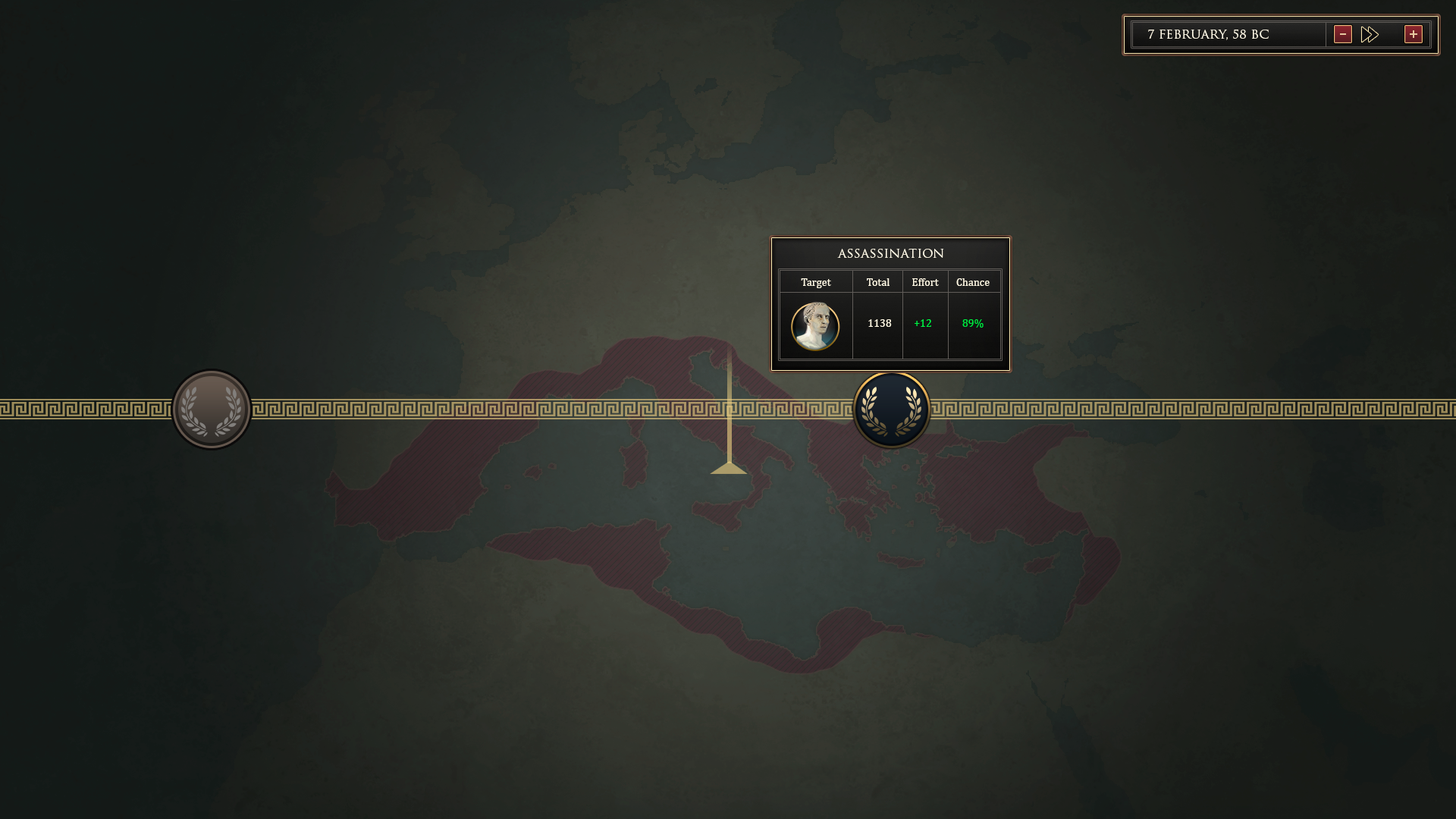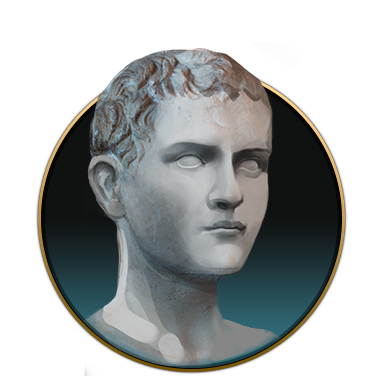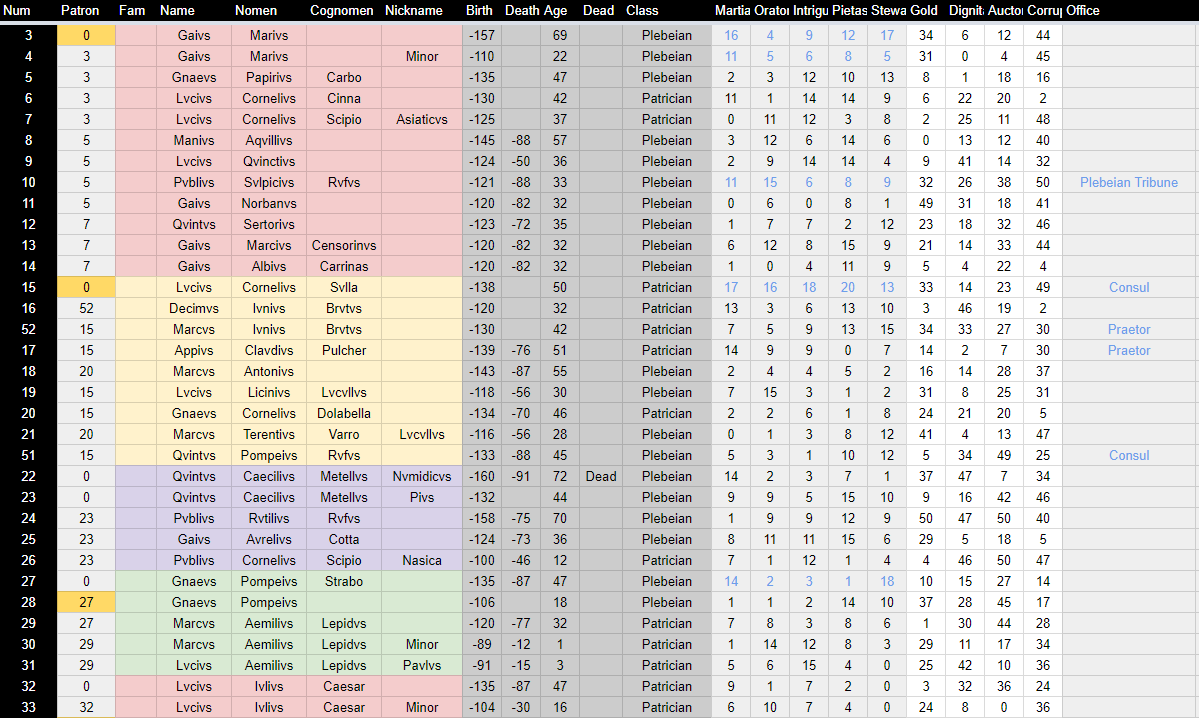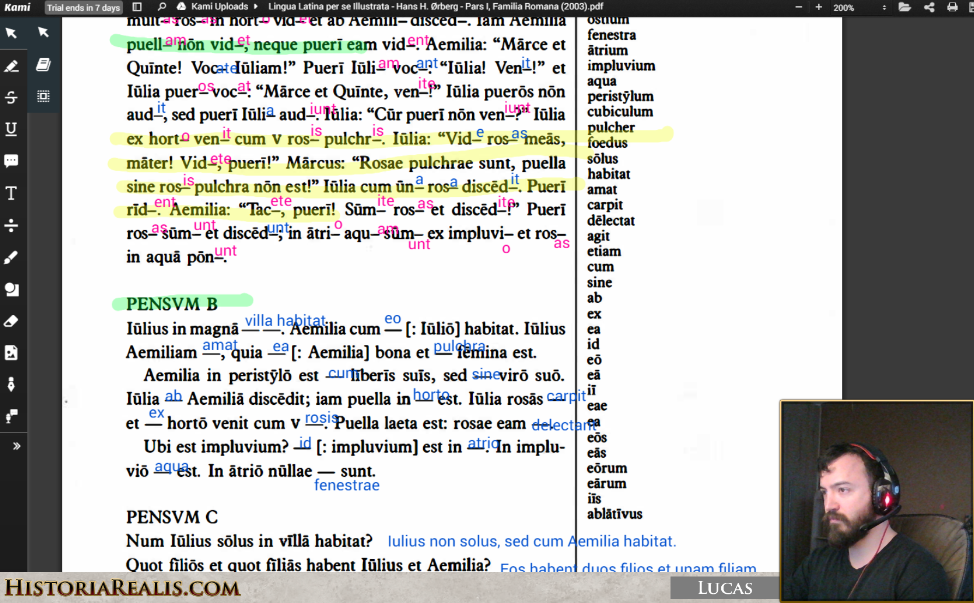INTRO
Hi! My name is Lucas and I'm making a game called Historia Realis: Roma. It's a simulation/grand strategy game set in Ancient Rome and inspired by Crusader Kings 2. I announced it just a week before Paradox announced their own Imperator: Rome. The difference between the two games is that Imperator is about map expansion, while Historia Realis is about political intrigue.
 SUMMARY
SUMMARY
This is the summary of what I worked on for Historia Realis: Roma this week:
-
CODE: Structured the data processing system of the simulation. Prototyped events.
-
CONTENT: Created a database of Roman characters in 88 BC, both historical and generated.
-
ART: Marble bust of Caligula as a generic portrait.
-
COMMUNICATION: Streamed on Twitch, learning Latin and roman history. I also wrote this diary.
PROTOTYPES
I had previously only shown mockups of the game, which are plans of how it's going to look. For example, this the mockup for the timeline.
The timeline is where the player can see upcoming events and decide if they want to join any of them. Someone is gonna murder Caesar? You can see that and try to stop it, or help it. There are elections for Consul coming up? You can join that event to become a candidate. All actions of all characters happen in this timeline.
Here is the timeline prototype working. Please keep in mind this is a pre-alpha image, very early in development. The graphics haven't been even put in the game yet because the focus is still on the code.
Timeline prototype
In the above simulation, there are 1000 characters participating in about 200 events. Each little square is an event, and the list in the bottom left shows which characters are in which events. I expected there would be too many events and characters to make things readable, but I didn't expect it to be this hard to read. So I split the timeline into a few timelines to make it more readable:
There you can see the huge amount of events a bit more clearly, but it's still not readable to a player. The point is that these are just too many events and characters for a single person to deal with. The player needs to see less. In CK2, for example, you usually don't know what the characters in India are doing (if you're playing as an european). It's like they're not even there, but they're still being simulated. Similarly, HR:R will have to hide information from the player, even though the simulation is running those events.
This is not a bad thing. It works well if you think about how people live in society. You don't know what's going on with everybody. You know about your family, your close friends, and maybe about important and famous people. That's how it works in real life, and that's how it worked in Rome too. So who would be your social circle in Rome?
This is a prototype for hierarchies. Each square finds a square of lower value and makes him a vassal, or "client" in Ancient Roman terms. The liege, or "patron" becomes stronger by acquiring this client, and can then get another client. His clients can have clients too. Even starting from total chaos, this simulation creates neat hierarchies of factions much like the patronage system of Rome.
So your social circle is inside this hierarchy: you'd know your patron, your fellow clients and your family. Those might be about 10 people. And when those people start an event, you'll see it in the timeline. And only people from that social circle will be able to join the event. So you might see an average of 5 events on-screen at any point. Much more readable than 200. But implementing that is for next week.
A cool consequence of this social circle mechanic is that expanding your social circle could be an important action in the game, as that gets you access to more events. Or you could try to leave your current circle and join someone else with more opportunities. Romans did that a lot.
ART - MARBLE BUST OF CALIGULA
This is a bust of Caligula I painted to be used as a portrait in the game.
He's out of the time period, but he seemed to me like the Roman with the most "standard" face. Portraits in HR:R are going to be marble busts. I'm painting them myself in Photoshop, and the way they are gonna work is they'll have different layers with facial features: nose, mouth, eyes, hair and so on. Those features will be randomized for generated characters so that each one gets a unique look, and children can look like their parents. I'm also using this art in the stream, as it shows up on-screen when someone follows the channel.
FIRST START DATE: 88 BC
Sulla's first Civil War started in 88 BC, when Marius schemed to take the command of the Mithridatic campaign from him. So Sulla marched on Rome instead. I think this is a good start date because it contains all the coolest characters I've been reading about: Sulla, Marius, Pompey, Crassus and even Caesar, Cicero and Cato, although they were still young and unimportant.
So I made this database of characters. You can actually comment on it, or here, if you find something wrong. It's not finished yet, as I haven't added traits, for example. I'm gonna ask for some help with that soon!
Another good thing about the start date of 88 BC is that it differentiates HR:R from Imperator (which starts at 300 BC).
TWITCH STREAM
I started streaming on Twitch and it's been pretty good so far. Answering questions in chat is particularly helpful to me, as it forces me to think about some design things I hadn't thought of. Learning Latin is cool as always, and the historical research always gives me new content and ideas for the game.
Me streaming Latin on Twitch
There were a couple of problems, though. Europeans were mostly unable to watch because it started so late in their timezone, and streaming 4 times in the week was a bit tiresome for me. So for next week I'm gonna try to solve those two problems with a new schedule:
-
MON: 9 PM EST (same time as usual)
-
TUE: 6 PM EST (3 hours earlier than usual)
-
WED: 4 PM EST (5 hours earlier than usual)
Timezones are super annoying to convert, though. So my suggestion is you just follow the stream to get an email notification when I start streaming. This schedule is a test anyway.
Oh, and I became a Twitch partner thanks to you guys! I got the invitation due to the number of watchers and hours streamed. I'm not sure what that means yet, but apparently now you can subscribe to the channel and the usual Twitch stuff. I don't know if we're gonna roll with that, but we'll see how it goes.
Thanks!
All of the things I mentioned in this dev diary appeared in the stream in one form or another, so that's the best way to get information on the development of Historia Realis.






